This third game went a lot faster than the last, taking about twelve
days of real time to run.
The scenario was The Russians Are Coming, from the now-obscure
1987 GDW scenario book Battles of the Third World War (largely
superseded by 2003's High Tide but I still find the contents
interesting). A Soviet surface action group takes on a Norwegian
picket ship and supporting forces, aiming to destroy it with as little
consumption of resources (especially missiles) as possible, and as far
as can be achieved denying the enemy information on which specific
ships and classes were involved.
This is where having hidden information became really important. I
gave the players briefings out of the book, but they didn't know
exactly what opposition they'd be facing. In particular, the Soviets
were quite reasonably worried about the Norwegians' Ula-class diesel
submarines. In fact, the Norwegians just had a flotilla of eight fast
missile/torpedo boats (of the Hauk, Snøgg and Storm classes).
The Soviets set up in two groups, putting a Kara, a Sovremennyy
and an Udaloy forward while keeping the Kirov-class BCGN and
supporting Krivak/I frigate well back. In fact, the rear force ended
up playing no part in the battle except by providing a little
helicopter support.
(All images are links to larger versions.)

The Soviets put up a helicopter advancing with their forward group,
and the patrol ship Andenes was able to spot it at once by ESM. It
didn't help to locate the Norwegian patrol boats, which were not only
very small radar targets over its horizon but tucked away in a fjord
near a steep rock wall.

Andenes started moving towards the coast for protection against
radar-guided missiles, then traversed back and forth for ESM
cross-bearings. The Soviet forward force crossed the radar horizon,
but at this point everyone was still claiming to be non-hostile, and
the Norwegians weren't allowed to open fire until fired on. The Soviet
helicopter conducted dipping sonar operations, looking for those
elusive diesel boats.

They did however put up Andenes' Lynx helicopter. The Soviets did
their best to warn it away by locking on SAM guidance radar, but the
pilot was undeterred, and moved in close enough to the forward force
to get visual identification of all three ships.

The Lynx landed at the local airfield at Svartnes, on the basis that
it had done its job: it had no search radar, its torpedoes were only
capable against submarines, and Andenes probably wasn't long for
this world.

The Soviets opened fire on Andenes. Knowing that radar-guided
missiles wouldn't work, and becoming impatient with the slow progress
towards gun range, they used a pair of Metel missiles (SS-N-14
Silex). This is a curious device, which began its life as a
torpedo-carrying rocket for anti-submarine work (like the ASROC or
Ikara); later generations use a lighter torpedo, so there is also room
for an IR guidance package and anti-ship warhead as well. IR guidance
is not confused by proximity to the coastline.
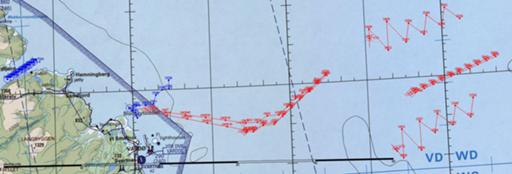
Andenes spotted the incoming missiles fairly late and couldn't do
much about them, but did get off a distress call and snap-launch her
own Penguin missiles towards the enemy before being sunk. They were
taken down by SAM fire.
The patrol boats got under way towards the last known Soviet
positions. As they rounded the headland, they got ESM hits for
guidance.
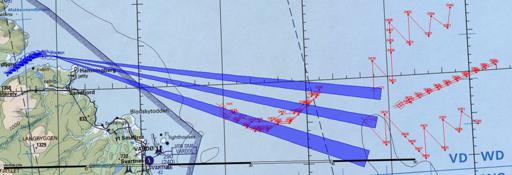
This is probably the most complex ESM plot I've produced to date.
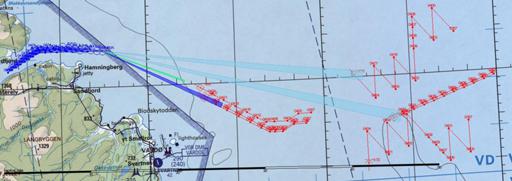
Several things happened at once. The patrol boats turned on their own
radars just as they were coming into Soviet detection range (only
about ten miles given their small size). The Udaloy opened up with
130mm gunfire, but didn't have much luck at first. The patrol boats
launched their own Penguin missiles at the Soviet force, some forty in
total.
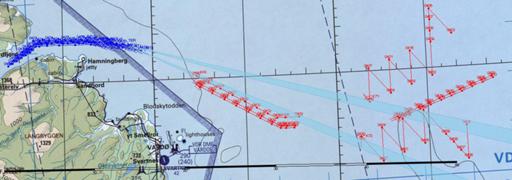
Over the next few minutes, the Soviets sent up a wall of SAM fire,
whittling down the incoming missiles at the cost of draining their own
magazines. In the end just one Penguin hit, striking the Sovremennyy
and damaging his rudder.
One Soviet helicopter moved in from the Kirov in the hope of providing
torpedo support. The Norwegian boats fired their Tp 61 torpedoes and
continued to close in behind them, exchanging gunfire with the Soviets
(and, with one very lucky hit, causing major flooding aboard the
Kara) as they were whittled down. The Soviets had reduced speed
after the Sovremennyy was hit, but even so were unable to detect the
torpedoes until they were very close. At which point they went into
evasive manoeuvres, and started actively pinging, looking for that
[censored] submarine…
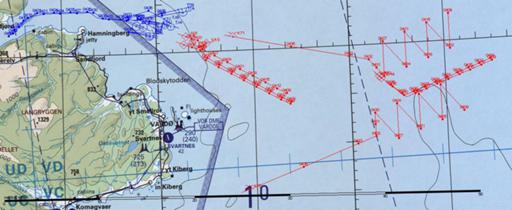
The Norwegian boats were all sunk by gunfire, but their torpedoes kept
running. Some were off target, some missed, but three hit the Kara
and two the Udaloy, sinking both.
Which was enough to give the Norwegians a major victory, even with the
total loss of their own forces (which to some extent was expected). A
decisive victory would have seen them sinking the Kirov, but apart
from one brief ESM contact they didn't get a sniff of him.
Thanks to Todd (Blue) and Luiz and Peirof (Red) for playing. The
moment-by-moment maps as shown to each player are
available here. Things
I've learned from running this game:
-
Once again everyone started pretty close. We had detection of the
Soviet helicopter from the very first turn. When I'm designing
scenarios I plan to start forces further apart, and have more of a
search phase, as in Gulf Escort Déja Vu.
-
This is the first time I've had occasion to run surface-to-surface
gunfire, ditto torpedoes, ditto sonar detection. I still don't think
I'm fully conversant with the current rules (I want more practice
with sonar, and I've barely touched submarines at all), but I've had
a pleasantly graduated introduction. (I played a fair bit back in
the late 1980s and early 1990s, but my memory is hazy and in any
case the rules have changed a bit since then.)
-
I am not a robot moderator. If a player says "hey, there's a
airfield over there on the map, I want to land at it", I can look up
details and agree that it's a possibility rather than refusing
because it's not in the scenario notes. We're all in this to have
fun, and just as in a role-playing game it's often more interesting
to say "yes, but" rather than "no" when the rules don't give an
explicit answer.
-
I like asymmetrical scenarios, something that's missing in a lot of
games with tournament activity. I'd much rather play something like
this, where one side is clearly going to dominate the battlefield
but the victory conditions are skewed so that domination on its own
is not enough, then an equal-point-value brawl.
-
Calculating a leading intercept course (i.e. the target is going in
a straight line, what course should you steer to reach him in the
minimum time, as opposed to simply pointing straight towards him
which will take longer) isn't as complex as I'd thought it would be,
and I've now added it to the orders system. (The trick was to
transform the coordinate systems. If you put yourself at the origin
and your target is directly up the Y-axis, his transverse (X) speed
is his speed multiplied by the cosine of his course angle, and in
order to keep the bearing constant your transverse speed should be
the same.)
-
Denying information is fun, at least for some sorts of player.
Having to work with the limited information available from an
intelligence brief, rather than knowing exactly what your opponent
is bringing to the fight because you've both read the same scenario
notes, adds a layer of realism and makes everyone's job that bit
more challenging.
-
And I still haven't had enough. I hope to start another game shortly.
Comments on this post are now closed. If you have particular grounds for adding a late comment, comment on a more recent post quoting the URL of this one.